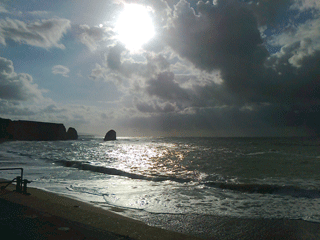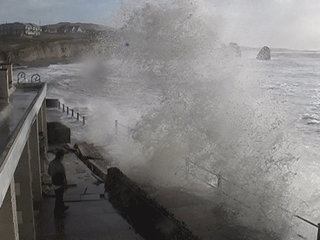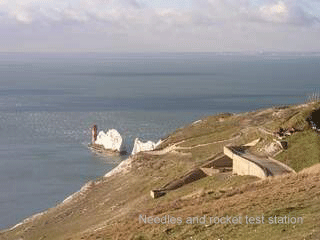






 | ||
 |
 |
 |
 |
 |
 |
|
About Freshwater Bay Isle of Wight, United Kingdom. | ||
 |
Freshwater Bay is a small coastal inlet in the beautiful western end of the Isle of Wight. The Island is situated off the coast of southern England close to the cities of Southampton and Portsmouth. The Bay was once known as Freshwater Gate as it is the only significant break in the line of cliffs extending from the Needles to the west and Shanklin in the east. The chalk ridge running along the south coast of England is very dominant in the west of the Island and the Bay cuts into this to create two local downs, Tennyson to the west and Afton to the east. | |

| The Bay has a man made promenade on top of a barrier that prevents the sea from joining with the river Yar and thus separating the western end of the Island. On the other side of the public car park at the Bay Afton Marsh extends down towards the head of the River Yar. This is a small but important wetland that is of great interest to naturalists and botanists. The Bay is part of the area of outstanding natural beauty (AONB) and is surrounded by farm land and areas owned by the National Trust. As well as the Bay itself the local area boasts fine unspoilt beaches, scenic walks and a real get away from it all atmosphere. It is a compliment to the area that it is not only popular amongst tourists, but is also visited by other islanders. | |
 | With the mild maritime climate created by the fact that the Solent and English Channel are only one mile apart at this point, it is a popular place for active residents. Frosts do not last in the winter and snow fall is rare. With no heavy industry locally the air has a clarity that is much sought after by photographers and astronomers. Rainfall is low but frontal winds can create spectacular waves. These result in ideal surfing conditions within the Bay and along the coast a little at Compton Bay. | |

|
On the western end of the Bay, the bluff is dominated by the remains of Fort Redoubt, one of a series of Forts built by Lord Palmerston along the Island shore. These were built in the mid 19th centry as defence against the French. With the large maritime ports of Southampton and Portsmouth, the Island was seen as a first line of defence. The visible building is now a private home but was for many years a cafe. | |
|
|
Along the promenade is the Freshwater Bay Lifeboat Station. This is not part of the RNLI service and so relies on public donation and the takings from shop sales. There are two boats stationed here, both being rigid inflatables. The lifeboat is on call 24 hours a day and seven days a week, an all year service! Lifeboat crew practice takes place on Sunday mornings when a crew member, if asked nicely, would be happy to show visitors around the lifeboat and station. The steps at the eastern end of the promenade lead up onto the start of Afton Down. The coastal path follows the line of the Military Road as it makes its way upwards and then down to Compton Bay. Above the Military Road is Freshwater Golf Course, a very scenic round and, in a good breeze, demanding! | |
|
|
Taking Gate Lane, a name change for the Military Road as it heads westwards for Alum Bay, the first point of interest is Dimbola Lodge. Once home to the pioneer lady photographer Julia Margaret Cameron, it now houses galleries,a photography museum, shop and tea room. Mrs Cameron was a friend of Alfred, Lord Tennyson and photographed many of his famous visitors as well as illustrating some of his poems. The museum stages temporary exhibitions as well as holding permanent exhibits of Mrs Cameron's work and a pictorial history of the Isle of Wight Pop festivals. | |
|
Heading further along Gate Lane a popular photographic location is St Agnes'
church, one of only eight remaining thatched churches left in the British Isles. The recently restored foundation stone was laid on April8 1908 by Tennyson's young grandson Harold. He was killed in 1906 when his ship Viking was blown up in The Channel and is buried with the family in All Saints' churchyard. Beyond that is the former Freshwater Bay Post Office, now a splendid cafe, and a quintessentially English corner shop called Orchards, which has been run by the same family for 150 years. | |
|
| The road to the left passes Farringford, about one kilometer from the Bay. Farringford was the home of Alfred, Lord Tennyson when he was poet laureate to Queen Victoria. Much work has been done in restoring the house to the state which Tennyson knew. The house is to open to the public when restrictions allow, and the gardens are open to visitors now. The grounds also house holiday cottages to let.Farringford. | |

| This is as far as the Residents' Association extends but anybody travelling along Bedbury Lane and onwards will eventually come to Alum Bay and the Isle of Wight's most famous landmark, The Needles. | |
 | ||